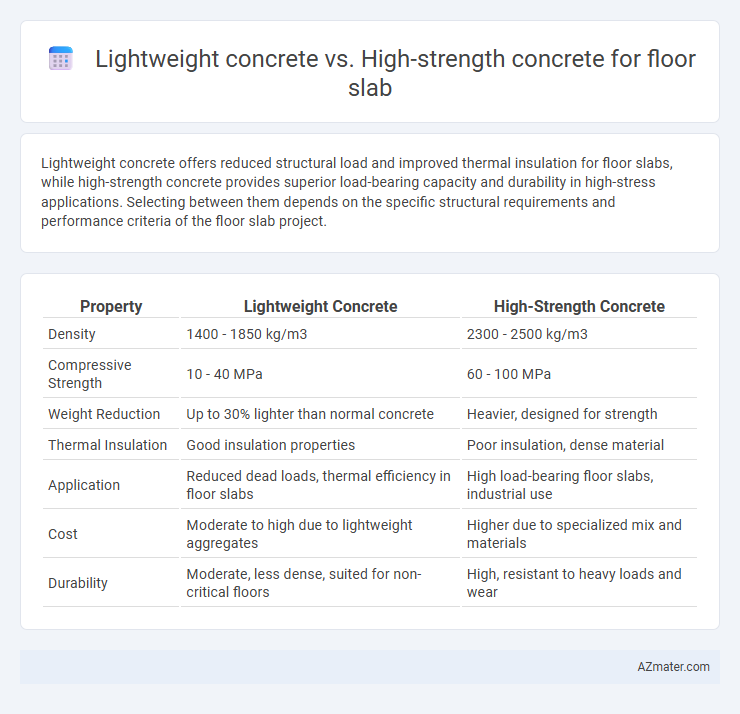Lightweight concrete offers reduced structural load and improved thermal insulation for floor slabs, while high-strength concrete provides superior load-bearing capacity and durability in high-stress applications. Selecting between them depends on the specific structural requirements and performance criteria of the floor slab project.
Table of Comparison
| Property | Lightweight Concrete | High-Strength Concrete |
|---|---|---|
| Density | 1400 - 1850 kg/m3 | 2300 - 2500 kg/m3 |
| Compressive Strength | 10 - 40 MPa | 60 - 100 MPa |
| Weight Reduction | Up to 30% lighter than normal concrete | Heavier, designed for strength |
| Thermal Insulation | Good insulation properties | Poor insulation, dense material |
| Application | Reduced dead loads, thermal efficiency in floor slabs | High load-bearing floor slabs, industrial use |
| Cost | Moderate to high due to lightweight aggregates | Higher due to specialized mix and materials |
| Durability | Moderate, less dense, suited for non-critical floors | High, resistant to heavy loads and wear |
Introduction to Floor Slab Concrete Types
Lightweight concrete for floor slabs offers reduced dead load, improved thermal insulation, and enhanced fire resistance, making it ideal for long-span structures and seismic zones. High-strength concrete provides superior load-bearing capacity and durability, suitable for heavy-duty floors and industrial buildings requiring high performance. Both types serve distinct structural needs, balancing weight and strength based on project specifications and design criteria.
Understanding Lightweight Concrete
Lightweight concrete offers reduced density typically ranging from 1,440 to 1,840 kg/m3, making it ideal for floor slabs requiring lower dead loads and enhanced thermal insulation. Its cellular structure, often achieved by incorporating expanded aggregates or air-entraining agents, improves fire resistance and sound insulation compared to high-strength concrete, which prioritizes compressive strength above 40 MPa. Understanding the balance between strength and weight is essential for selecting lightweight concrete when the main goal is reducing structural load without significantly compromising durability or performance.
Overview of High-Strength Concrete
High-strength concrete for floor slabs typically exhibits compressive strengths above 6,000 psi, offering superior load-bearing capacity and durability compared to lightweight concrete. It enhances structural performance by reducing slab thickness while maintaining high stiffness and resistance to cracking. This type of concrete is commonly utilized in commercial and industrial buildings requiring long spans and heavy-load support.
Key Material Properties Comparison
Lightweight concrete for floor slabs offers lower density, typically between 1600 and 1850 kg/m3, reducing dead load and improving thermal insulation compared to high-strength concrete, which ranges from 2400 to 2500 kg/m3. High-strength concrete exhibits compressive strengths exceeding 50 MPa, providing superior load-bearing capacity, while lightweight concrete usually achieves compressive strengths between 17 to 40 MPa. The modulus of elasticity for lightweight concrete is lower, around 10-20 GPa, compared to 25-40 GPa for high-strength concrete, influencing slab stiffness and deflection characteristics.
Structural Performance in Floor Slabs
Lightweight concrete offers reduced dead load, enhancing structural efficiency and lowering foundation costs in floor slabs, while providing sufficient strength for moderate loads. High-strength concrete enables thinner slabs with higher load-bearing capacity and improved durability, suitable for heavy-duty applications and longer spans. Structural performance comparisons show high-strength concrete optimizes floor slab stiffness and crack resistance, whereas lightweight concrete benefits energy absorption and seismic resilience.
Weight Implications on Building Design
Lightweight concrete significantly reduces the overall load on floor slabs, decreasing dead load by up to 30-40%, which allows for smaller structural supports and foundations in building design. High-strength concrete, while providing superior compressive strength above 6000 psi, typically has a higher density of around 2400 kg/m3 compared to lightweight concrete's 1600-1900 kg/m3, thus increasing floor slab weight. Choosing lightweight concrete optimizes seismic performance and cost-effectiveness by minimizing structural mass, whereas high-strength concrete is preferred for load-critical applications requiring smaller slab thickness despite its weight.
Cost and Economic Considerations
Lightweight concrete for floor slabs offers cost savings through reduced structural load, leading to lower foundation and framing expenses, making it economically favorable for large-scale projects prioritizing weight reduction. High-strength concrete, while more expensive per cubic meter, can reduce slab thickness and increase load capacity, resulting in long-term durability and lower maintenance costs that may offset initial investment. Evaluating the total cost of ownership, including material, labor, and lifecycle performance, determines the optimal choice between lightweight and high-strength concrete for specific flooring applications.
Installation and Construction Techniques
Lightweight concrete offers easier handling and faster installation for floor slabs due to its reduced density, decreasing labor time and equipment load requirements. High-strength concrete requires precise mixing, placement, and curing techniques to achieve its specified compressive strength, often necessitating skilled labor and specialized equipment for vibration and formwork support. Both types demand careful attention to slab thickness and reinforcement placement to ensure structural integrity and durability.
Durability and Maintenance Factors
Lightweight concrete offers enhanced thermal insulation and reduced dead load, leading to lower maintenance costs, but it generally exhibits lower compressive strength and durability compared to high-strength concrete in floor slabs. High-strength concrete provides superior durability with increased resistance to cracking, abrasion, and chemical attack, significantly reducing long-term maintenance requirements in high-traffic or industrial environments. Selecting between the two depends on balancing load demands and environmental exposure, with high-strength concrete preferred for durability-critical applications demanding minimal upkeep.
Best Applications for Each Concrete Type
Lightweight concrete is ideal for floor slabs in multi-story buildings where reducing dead load is critical, enhancing seismic performance and simplifying structural support. High-strength concrete suits floor slabs requiring superior load-bearing capacity, such as industrial warehouses, bridges, and heavy traffic areas, providing enhanced durability and resistance to wear. Selecting between lightweight and high-strength concrete depends on project-specific factors including structural demands, weight limitations, and longevity requirements.

Infographic: Lightweight concrete vs High-strength concrete for Floor slab
 azmater.com
azmater.com